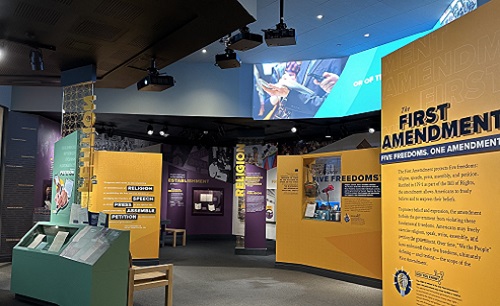This activity is part of Module 6: Separation of Powers and Federalism from the Constitution 101 Curriculum.
Introduction to the Constitution's Text
Let’s begin—as we always do when interpreting the Constitution—with the Constitution’s text.
The Constitution sets up three branches of government. Article I establishes the national government’s legislative branch—Congress—which makes the laws. Article III sets up the nation’s court system—with the Supreme Court at the top—which interprets the laws.
Article II establishes the national government’s executive branch. Within the national government, the executive branch is responsible for enforcing the laws.
We commonly think of the presidency as the most powerful elected office in all of the world. Yet, the Constitution actually grants far fewer explicit powers to the president in Article II than it does to Congress in Article I.
Article II
Article II “vest[s]” the “executive Power . . . of the United States” in a single president. It sets out the details for how we elect a president (namely, through the Electoral College) and how we might remove one from office (namely, through the impeachment and removal process). It also lists some of the president’s core powers and responsibilities, including:
- Her role as “Commander in Chief of the Army and Navy of the United States.”
- Her power to:
- Appoint judges and executive branch officials with the advice and consent of the Senate.
- “[M]ake Treaties, provided two thirds of the Senators present concur.”
- “[G]rant Reprieves and Pardons for Offences against the United States, except in Cases of Impeachment.”
- Her duty to “take Care that the Laws be faithfully executed.”
Articles I and III
In Article I, the Constitution also gives the president the power to veto legislation passed by Congress. At the same time, the Constitution’s system of checks and balances ensures that the other two branches—Congress and the Supreme Court—can check the president.
For instance, the president may be able to veto a law passed by Congress. But Congress has the power to override the president’s veto—to cancel it—with a two-thirds vote in both houses of Congress. The Constitution also gives the president the power to appoint Supreme Court justices, but those appointments must be approved by the Senate. The same goes for new treaties with other countries.
Finally, the Supreme Court has the power to review the president’s actions—for instance, new executive orders—and decide whether those actions were constitutional or unconstitutional.
Reelection and Age
Here’s the 22nd Amendment’s language:
“No person shall be elected to the office of the President more than twice, and no person who has held the office of President, or acted as President, for more than two years of a term to which some other person was elected President shall be elected to the office of the President more than once…”
This language effectively limits the president to two terms of office, a precedent first set by George Washington.
The president must be at least 35 years old. In part, this age requirement guarded against the danger of politicians being elected to office based on their famous names—giving candidates from famous families enough time to live their lives, gain valuable experience, and provide the public with a record of their own for judging whether they were fit to be president.
Articles II, Section 4
Article II, Section 4, sets out the process for impeachment and removal.
It reads as follows: The “President, Vice President and all civil Officers of the United States” shall be removed from office if convicted in an impeachment trial of “Treason, Bribery, or other high Crimes and Misdemeanors.” Two clauses in Article I lay out the role of the House of Representatives and the Senate in this process. The House has the power to impeach—by a majority vote. An impeachment is a formal charge against the president, but does not remove her from office. Once the president is impeached, the Senate then has the power to hold an impeachment trial and may remove a president from office with a two-thirds vote. In practice, impeachments by the House have been rare. Only three presidents have been impeached and no president has been removed by the Senate. (Although President Nixon did resign from office, and Andrew Johnson was only a single vote away!)
25th Amendment
This 25th Amendment addresses the issue of presidential disability and succession.
Section 1 says that when the president dies, resigns, or is removed from office, the vice president becomes president. (So, when President Nixon resigned, his vice president—Gerald Ford—became president under the 25th Amendment.)
Section 2 sets out the process for filling an open seat for vice president. The president nominates a new vice president, and both the House and the Senate must approve of the pick by majority vote in each house. (So, when Vice President Spiro Agnew resigned in 1973, President Nixon selected Gerald Ford as vice president, and the House and Senate confirmed the pick.)
Section 3 permits the president to temporarily transfer power by a written statement that he is “unable to discharge the powers and duties of his office.” The president can then resume his responsibility with a second written statement saying that he’s ready for duty. (So, President Reagan transferred his authority to Vice President Bush for a few hours while he had a planned surgery.)
Section 4 addresses the situation where a president refuses to transfer his duties when others might conclude that he is unable to fulfill them. It’s a pretty complicated process.
Big Idea: With the new president, the Founding generation set out to establish an executive head stronger than the weak governors in charge of the states at the time, but weaker than a king.






